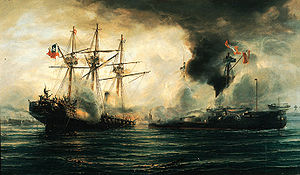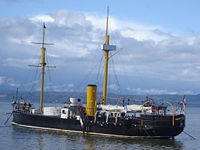- Huáscar (ironclad)
-

Huáscar when with the Peruvian NavyCareer (Peru) 
Name: Huáscar Ordered: 4 August 1864 Builder: Laird Brothers, Birkenhead, England Launched: 7 October 1865 Commissioned: 8 November 1866 Fate: Captured by Chile at the Battle of Angamos on 8 October 1879 Career (Chile) 
Acquired: 8 October 1879 Decommissioned: 1897 Reinstated: 1934 Status: Museum ship General characteristics Displacement: 1,180 long tons (1,199 t) Length: 66.9 m (219 ft) Beam: 10.9 m (35.8 ft) Draught: 5.7 m (18.7 ft) Propulsion: 1 x steam engine,
1500 hp (1120 kW),
single screwSail plan: Brigantine Speed: 12 knots (22.2 km/h) Complement: 170 Armament: - 2 x 10" (254 mm), 300 lb (136 kg) Armstrong guns in a single Coles turret
- 2 x 4.75" (120 mm), 40 lb (18 kg) Armstrong guns
- 1 x 12 lb (5 kg) cannon
- 1 x .44 cal Gatling gun
- Armoured ram bow
Armour: - 4.5" (114 mm) iron belt (amidships), tapering to 2.5" (64 mm) (prow and bow)
- 5.5" (140 mm) iron turret
Huáscar is a 19th century small armoured turret ship of a type similar to a monitor. She was built in Britain for Peru and played a significant role in the battle of Pacocha and the War of the Pacific against Chile before being captured and commissioned with the Chilean Navy. Today she is one of the few surviving ships of her type. The ship has been restored and is currently commissioned as a memorial ship. She is named after the 16th century Inca emperor, Huáscar.[1]
Contents
History as a warship
Huáscar was ordered by the government of Peru from the Laird Brothers shipyards in 1864 for the war against Spain. Lairds had extensive experience of these advanced ships, designing and building the Laird Rams. She was launched in Birkenhead on 7 October 1865.
Commanded by Chilean Captain José María Salcedo, who had supervised construction on behalf of the Peruvian Navy, she left for Peru on 20 January 1866 on a trip that saw some trouble: a month-long wait at Brest, a minor collision with the ironclad Independencia on 28 February, refusal of service by neutral countries, a month of repairs at Rio de Janeiro, insubordination by Independencia's commander and the capture and sinking of the Spanish brigantine Manuel. When she finally arrived in port at Ancud in allied Chile to join the rest of the combined fleet on 7 June, it was too late for her to participate in the conflict.
Under Captain Lizardo Montero, Huáscar prepared at Valparaíso to participate in a late 1866 expedition to fight the Spanish fleet at the Philippines. However Montero, with several other Peruvian officers, objected to plans for Rear Admiral John R. Tucker –formerly a commander of Confederate warships during the American civil war – to be in command of the fleet, and requested to be relieved. Captain Salcedo took back command of Huáscar, but the expedition was eventually cancelled.
On February 1868, Captain Miguel Grau took command of Huáscar and would remain until 1876, becoming her longest-serving commander. His long years aboard the ironclad would prove very valuable later and he would also become Peru's most renowned naval officer.
Peruvian Civil War (1877)
Huáscar participated in the Peruvian Civil War of 1877. Seized in port in Callao by rebels led by retired Captain Germán Astete, she was used to harass, sabotage and disrupt government forces and shipping lanes. During these actions foreign shipping was also affected, leading to British intervention.
On 29 May 1877, she fought the inconclusive Battle of Pacocha against two British vessels, the frigate HMS Shah and the corvette de Horsey. This battle saw the first use in anger of the newly-invented self-propelled torpedo which, at the time, had just entered limited service with the Royal Navy.
Huáscar surrendered to the government after almost one month in rebel hands. Although controlled by rebels at the time, popular and press pressure on the Peruvian government resulted in a formal diplomatic protest to the British government for its attack on the Huáscar; on another hand the British Parliament came close to censuring Admiral de Horsey for his failure to capture her.
Huáscar gained fame in Peru, and would later reach legendary status.
War of the Pacific (1879-1884)
Huáscar participated in the War of the Pacific, initially in the service of Peru. Once again under the command of Captain Miguel Grau, she became famous for daring harassment raids on Chilean ports and transports. As a result, during the opening months of the war, the ground invasion was delayed for almost six months until the Chilean fleet could find and stop Huáscar.
On 21 May 1879, Huáscar led the lifting of the Chilean blockade of Iquique. During the battle, Chilean Captain Arturo Prat was killed on Huáscar's deck while leading a boarding party from the corvette Esmeralda. After sinking the corvette by repeated ramming, Huáscar then rescued the survivors before continuing pursuit of a fleeing enemy ship.
Determined to avenge the sinking of Esmeralda and to secure the logistic lines needed for the invasion of Perú, the Chileans committed every possible unit to hunt down Huáscar. During the next 137 days Huáscar not only evaded the confrontation with the enemy fleet but made the coast unsecure for Chilean transport ships. Its biggest prize was Rimac with 260 men of a cavalry regiment.
On 8 October 1879, Huáscar was captured by the Chilean Navy at the Battle of Angamos, during which Rear Admiral Grau and 32 men of the crew (of total 204 men) were killed.
Huáscar then entered the service of the Chilean Navy. At Arica she fought an inconclusive duel with the Peruvian monitor Manco Cápac (formerly USS Oneota) while participating in the bombardment of the city –where her new commander Manuel Thomson was killed– and she also aided in the blockade of Callao.
After the war, Huáscar was renovated in 1885 and 1887, including renewal of boilers, new screw design, and all-new steam engines to move gun and artillery turrets.
On May 1888, as part of a ceremonial division commanded by Rear Admiral Luis Uribe, Huáscar brought the bodies of the officers from Esmeralda from their graves at Iquique to a new burial place at Valparaíso. Notably, these were the same officers killed on Huáscar's deck at the Battle of Iquique; Rear Admiral Uribe had been the Executive Officer aboard Esmeralda and a survivor of the battle.
Chilean Civil War (1891)
Huáscar participated in the Chilean Civil War of 1891 between government and congress. Undergoing major maintenance work at the onset of the war, she was seized and towed out of Valparaíso by the rebel-leaning Navy, and readied for action within three days.
Commanded by Captain José María Santa Cruz, she participated in the takeover of the port city of Taltal by the rebels, ran escort duty for convoys and protected rebel-held ports. She returned once more to the port of Iquique, this time to bombard the port city held by government forces.
After almost eight months of fighting, the war ended with the government's surrender.
Peacetime
Huáscar went on serving the Chilean Navy until a boiler explosion in 1897 at the Talcahuano military harbour resulted in her decommissioning. Partially repaired, she later served as the first submarine tender in the Chilean Navy from 1917 to 1930.
In the early 1930s Huáscar was taken in hand for reconditioning as a heritage ship. Recommissioned in 1934, Huáscar was now armed with two 8-inch guns, three 4.7 inch guns and four 47mm guns. The 1,870-ton ironclad now wore the flag of the Port Admiral at Talcahuano. As late as 1949 she was listed in Jane's Fighting Ships as a coast defense ship; the photograph of Huáscar in that year's edition dated from 1938.[2]
History as a memorial ship
When she was recommissioned in 1934, Huáscar was the oldest vessel of the Chilean Navy. Between 1951 and 1952, work was undertaken with the aim to completely restore her to her 1878 condition and declare her a shrine to the glory of both the Peruvian and Chilean Navies.
She became a floating museum and a memorial, displaying many objects and relics recovered from Navy warehouses or donated by private citizens from the Talcahuano and Concepción area, including:
- A shrine with portraits of the three commanders that lost their lives on her deck, set at the commander's quarters.
- A portrait gallery in the boilers room.
- A prayer room, duly authorized by the Archbishop of Concepción
Between 1971 and 1972, a second restoration phase was undertaken at Chilean Navy drydock in Talcahuano: the hull was completely repaired, and engines rebuilt according to original blueprints obtained in England. Since then, a strict maintenance program ensures survival and preservation for future generations.
In 1995, the World Ship Trust conferred the Maritime Heritage Award [1] on the Chilean Navy with for its restoration of Huáscar.
Huáscar is berthed at the port of Talcahuano, Chile and remained on display for visitors until 2010. The Talcahuano Naval Base and Shipyards were devastated by the 2010 Chile earthquake and the resulting tsunami; although Huáscar was in the base at the moment she survived with no apparent damage.[3]
Significance
The Huáscar is one of the few early ironclad era warships to survive, and one of the few still afloat. The Huáscar remains highly regarded in both Peru and Chile, being considered as the tomb of the Chilean Captains, Arturo Prat and Manuel Thompson, and the Peruvian admiral Miguel Grau.
References
- ^ "Ships of the World: Huascar". http://college.hmco.com/history/readerscomp/ships/html/sh_046900_huascar.htm. Retrieved 3 February 2010.
- ^ Francis E. McMurtrie and Raymond V.B. Blackman (editors), Jane's Fighting Ships 1949-50, p. 129. New York: The McGraw-Hill Book Company, 1949.
- ^ "CNN Video: Chile quake damage from above". http://edition.cnn.com/video/#/video/world/2010/02/27/vo.chile.aerials.damage.cnn. Retrieved 22 March 2010.
External links
- Pre-Dreadnought Preservation The Huáscar
- El Huascar (in Spanish)
- Model of the Huáscar (360-degree spin around)
- Marina de Guerra del Perú: BAP Huáscar (in Spanish)
- Video game based on the ironclad Huascar by petrocad3d.com, made in Peru (in Spanish)
- Armada de Chile current ships: Historic Relic Huáscar (English or Spanish version)
Coordinates: 36°42′19.7″S 73°6′41.1″W / 36.705472°S 73.111417°W
Categories:- Monitors of the Peruvian Navy
- Monitors of the United Kingdom
- Mersey-built ships
- 1865 ships
- Ships of the War of the Pacific
- Monitors of the Chilean Navy
- Museum ships in Chile
Wikimedia Foundation. 2010.


